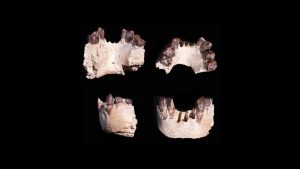
Image credit Mission Paleoanthropoligique Franco-Tchadienne—https://australian.museum/learn/science/human-evolution/australopithecus-bahrelghazali/
Australopithecus bahrelghazali, found in the Bahr el Gazel region of Chad, is a hominin species dated to around 3.5 million years ago known only from a few specimens. All other members of the genus Australopithecus are from eastern or southern Africa, making it the only australopith from central Africa. The species is known only from the holotype mandible, KT12/H1, an isolated premolar, and an undescribed mandibular fragment mentioned in a later publication.
In the original publication, the authors differentiated Au. bahrelghazali from its contemporary, Australopithecus afarensis, and other closely-related hominin species based on the morphology of the holotype mandible. The less-inclined mandibular symphysis, the region where either half of the mandible meets at the chin, a bicuspid (two-cusped) lower premolar, and a few other traits of the mandible differentiates Au. bahrelghazali from the slightly older species Au. anamensis. Au. bahrelghazali would have lived at the same time as Au. afarensis, but the authors consider it a separate species due to certain features of the holotype mandible and paratype premolar. The body of the front of the mandible, in the region of the chin, is flatter in Au. bahrelghazali than in Au. afarensis, and the premolar has three distinct roots.
However, the validity of Au. bahrelghazali as a distinct species has been questioned by some, who consider it a geographic variant of Au. afarensis. They consider some of the features described above as being within the range of variation seen in Au. afarensis.